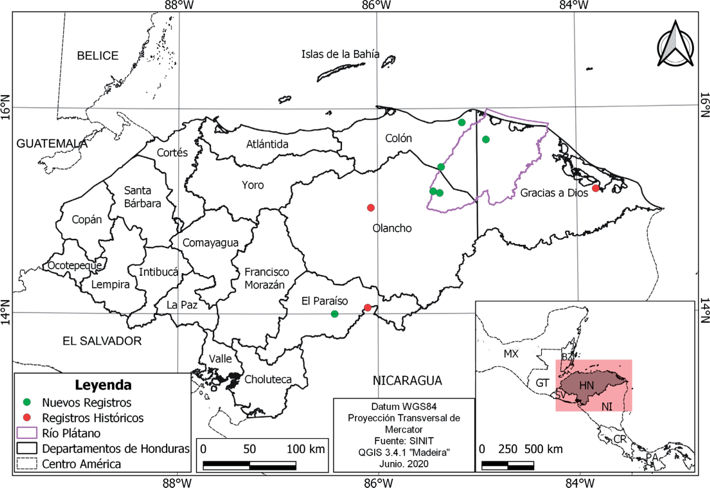El perezoso de dos dedos (Choloepus hoffmanni) en Honduras: distribución, historia natural y conservación
DOI:
https://doi.org/10.31687/saremNMS.20.0.25Abstract
Choloepus hoffmanni Peters, 1858 has been poorly studied in Honduras, the country within the northernmost distribution for the species. Here we present some observations about its distribution, diet, behavior, and threats in the country. The species was previously known from 11 localities, to which we added six new ones. Of the 17 records, the species is known from only six direct observations; one of them (Los Naranjos, Colón department) extends its known global range to northern Honduras. Wild individuals mainly fed on Cecropia Loefl., but also on Inga vera Willd. In addition to rapid habitat loss, illegal trade may become an important threat for the species in Honduras.
References
Acosta, I. 2015. Valoración económica del proceso de implementación de la Convención CITES en Honduras. Universidad Internacional de Andalucía, Baeza.
CITES. 2020. Convention on International Trade in Endangered Species of Wild Fauna and Flora. <http://www.cites.org>.
Escuela Nacional de Ciencias Forestales. 2013. Plan de Manejo Reserva del Hombre y la Biosfera Río Plátano (2013–2025). Asociación Internacional de Fomento (AIF) & Instituto Nacional de Conservación y Desarrollo Forestal, Áreas Protegidas y Vida Silvestre (ICF), Comayagüela, M.D.C.
Gamero, I. 1978. Mamíferos de mi tierra. 2 Volúmenes. Banco Central de Honduras, Tegucigalpa.
Hayssen, V. 2011. Choloepus hoffmanni (Pilosa: Megalonychidae). Mammalian Species 43:37–55.
Holdridge, L. R. 1987. Ecología basada en zonas de vida (H. Jiménez Saa, trad.). Instituto Interamericano de Cooperación para la Agricultura (IICA), San José.
ICF – Instituto Nacional de Conservación y Desarrollo Forestal, Áreas Protegidas y Vida Silvestre. 2016. Diagnóstico nacional de centros de conservación ex situ. Departamento de Vida Silvestre, Comayagüela, M.D.C.
McCarthy, T. J., D. Anderson, & G. A. Cruz. 1999. Tree sloths (Mammalia: Xenarthra). Nicaragua and Honduras, Central America. The Southwestern Naturalist 44:410–414.
Montgomery, G. G., & M. E. Sunquist. 1978. Habitat selection and use by two-toed and three-toed sloths. The ecology of arboreal folivores (G. G. Montgomery, ed.). Smithsonian Institution Press, Washington, D.C.
Plese, T., & A. Chiarello. 2014. Choloepus hoffmanni. The IUCN Red List of Threatened Species e.T4778A47439751. https://dx.doi.org/10.2305/IUCN.UK.2014-1.RLTS.T4778A47439751.en.
Plese, T., N. Reyes-Amaya, L. Castro-Vásquez, S. Giraldo, & O. Felixiano. 2016. Distribution and current state of knowledge of Hoffmann's two-toed sloth (Choloepus hoffmanni) in Colombia, with comments on the variations of its external morphological traits. Therya 7:407–421.
Reid, F. A. 2009. A field guide to the mammals of Central America & southeast Mexico. 2nd ed. Oxford University Press, New York.
Reyes-Amaya, N., D. Gutierrez, Y. Castillo-Navarro, R. A Rodríguez, & T. Plese. 2015. Información Demográfica de Bradypus variegatus, Choloepus hoffmanni y Cyclopes didactylus (Xenarthra: Pilosa) en un bosque húmedo tropical secundario de Santander, Colombia. Mastozoologia Neotropical 22:409–415.
Superina, M., T. Plese, N. Morales-Barros, & A. M. Abba. 2010. The 2010 sloth Red List assessment. Edentata 11:115–134.
Suutari, M., et al. 2010. Molecular evidence for a diverse green algal community growing in the hair of sloths and a specific association with Trichophilus welckeri (Chlorophyta, Ulvophyceae). BMC Evolutionary Biology 10:1–12.
Turcios-Casco, M. A., et al. 2020. A systematic revision of the bats (Chiroptera) of Honduras: an updated checklist with corroboration of historical specimens and new records. Zoosystematics and Evolution 96:411–429.
Urbani, B., & C. Bosque. 2007. Feeding ecology and postural behavior of the three-toed sloth (Bradypus variegatus flaccidus) in northern Venezuela. Mammalian Biology 72:321–329.
Vaughan, C., O. Ramírez, G. Herrera, & R. Guries. 2007. Spatial ecology and conservation of two sloth species in a cacao landscape in Limon, Costa Rica. Biodiversity and Conservation 16.

Downloads
Published
How to Cite
Issue
Section
License
Copyright (c) 2020 Marcio Martínez, Alejandro Velásquez, Shasling Pacheco-Amador, Nora Cabrera, Iris Acosta, Manfredo A. Turcios-Casco

This work is licensed under a Creative Commons Attribution-NonCommercial 4.0 International License.

